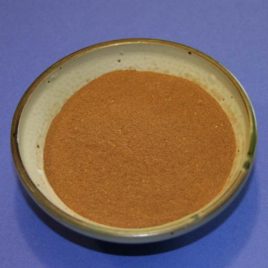Back to Ramie
Related products

Pomegranate, Ground Rind
Powdered/ground rind from the rinds of pomegranate fruits, Punica granatum. NOTE: this is NOT EXTRACT. This is the kind to use if you want to try it as a natural mordant.
We list this as a natural dye, but it is sometimes used as a mordant.
Use on protein or cellulose fibres. Yields soft yellows to green-yellows or gold. Substantive but pre-mordanting recommended. Use at 15-20% WOF for medium shades.
TO USE: soak 24 hours in hot water, stirring occasionally, then strain. Place liquid and fibre in dyepot and add more water if necessary. Bring to a high simmer for 1 hour. Let fibre cool in dye liquor for at least one more hour or overnight then wash and rinse.
Light and washfastness: moderate to good.

Ramie Top – Cyclamen
100% Ramie.
A beautiful shade of orchid-lavender-mauve. Hard to describe!
PRODUCT of ITALY

Ramie (Top)
100% Ramie.
Very clean combed top, in pencil-roving width. Staple length is 7 to 8 inches. Ramie comes from the stem (bast) fibre of a tropical plant. Typically it is bleached to an almost pure white. Our supply is very fine and soft. Ramie can be spun by itself or used in blends. It's well-suited for lighter summer wear, from against-the-skin to outerwear. An intriguing fibre for those that can't wear wool. <
Since this is a plant or cellulose fibre dyers must use fibre reactive dyes. Natural dyers can resort to techniques used on cotton, such as alum-tannin premordanting, or Aluminum acetate. We don't know how Ramie responds in an indigo vat.
That being said, when blended with protein fibres, acid dyes will leave the ramie alone during dyeing, which makes for some wonderful streaky or heathered effects, depending on how well the fibres are blended.

Ramie Top – Rust
100% Ramie.
Beautiful and rich rusty bronze-orange. Leans just slightly towards the browns.
PRODUCT of ITALY


